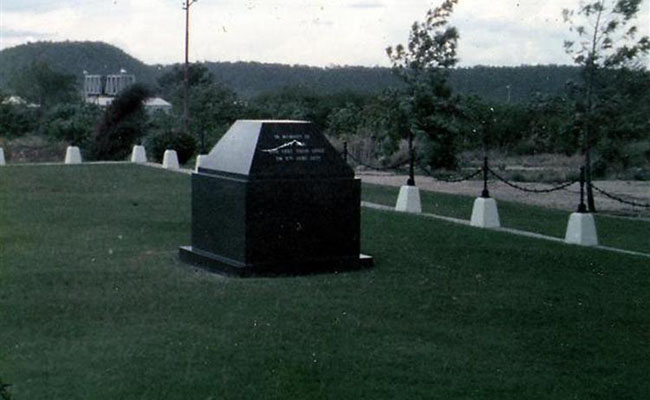‘Forgotten’ Hwange Disaster begs for answers 45 years on

Robson Sharuko
IT’s the last of the 10 recorded worst mining disasters, but on the 45th anniversary of the day when underground explosions at Hwange Colliery claimed the lives of 427 miners, it appears the world simply chose to forget and moved on as if nothing horrific happened that fateful day.For over four decades now, the world has never seen anything like the deadly events that engulfed the country’s biggest coalfields as the soul of this mining town was consumed by an underground fireball and poisonous gases which consumed 393 black miners and 33 of their white colleagues.
But, on the 45th anniversary of that disaster on Tuesday, the way those men met their death, ironically on a Tuesday on June 6, 1972, appeared not to provoke interest in a world that seems to have forgotten about them as if they didn’t exist at all.
Nothing on the rolling coverage of the BBC, nothing on CNN and nothing on Al Jazeera with all the major international television news networks engrossed in covering the terror attacks that hit London, the terror attack in Paris on Tuesday and the spectacular diplomatic fallout between Qatar and its Gulf neighbours.
Compare that with the way the international media covered the fifth anniversary, two years ago, of the 2010 Copiapo mining accident when 33 miners, who had been trapped at the San Jose copper/gold mine in northern Chile, were rescued alive after spending 69 days underground, and a difference emerges.
“Five years ago the world anxiously awaited 33 Chilean miners to rise from the rubble after a long 69 days of entrapment,’’ reported The New York Daily News.
“One by one, the workers, who ranged in age from 19 to 63, all made their way out of a 26-inch hole in the ground, greeted by a cheering crown that included Chile’s president Sebastian Piñera.
‘‘The miners were able to send back a note to the rescuers saying ‘We are fine in the refuge, the 33.’ Before the initial contact, however, desperation drove them to consider suicide and cannibalism.’’
CNN kept telling its viewers, in the lead up to that anniversary, they were going to air special report on the fifth anniversary of that disaster.
“Five years after the collapse of the San Jose gold and copper mine that trapped 33 miners for 69 days, CNN correspondent Rosa Flores travels to Chile to speak with three of the miners,’’ CNN said.
‘‘Their 69 days underground and their triumphant rescue stunned the world who watched it live on television. The men became globe-trotting celebrities with multiple movie and book offers.’’
The BBC chose to report about how the miners were reflecting ‘‘on changed lives, five years on,’’ in their coverage.
While the 33 Chilean miners lived to tell the horror of their tale, including inspiring the blockbuster movie “The33’’ starring Antonio Banderas, keep being remembered by the world, the same can’t be said of the 426 miners who were consumed by the fireball that swept underground at Hwange Colliery 45 years ago.
Questions inevitably, have to be asked:
l Is it because the majority of those who perished at the Colliery, 393 of them, were black miners?
l Is it because they were Africans and their lives probably don’t matter as much as their European or South American counterparts?
l Is it because it happened in Zimbabwe, or Rhodesia as it was known then, and who cares?
l Is it because these were just mere coalminers, not diamond or gold miners, and there is a huge difference in the values of the three minerals on the world commodity market?
l Is it because it happened 45 years ago, but if that is the case, why is it that the world annually remembers the Munich plane crash of 1958 – which happened 59 years ago – that wiped out a generation of some of the finest football stars to wear the iconic red strip of Manchester United?
l Is it because this happened at Hwange, on the western tip of Zimbabwe, and not in Newcastle, for centuries the coal-mining heartland of Britain, or in Wyoming, West Virginia or Pennsylvania coalfields of the United States of America?
Of course, it never used to be like this.
When the disaster exploded, it made headlines around the world, as can be seen in the incident being the front page story of the broadsheet Leader-Post daily newspaper of Canada on June 7, 1972, which led with the grim screaming headline – ‘‘NEW EXPLOSIONS END MINE’S RESCUE HOPES.’’
‘‘Rescue workers and mine officials today lost hope of saving any more of the hundreds of miners still trapped in the gas-filled Wankie Colliery,’’ the newspaper ran with a Reuters report of the disaster.
‘‘They haven’t a hope in hell,’’ a grim-faced miner said at the pithead.
“The temperature of the flames was hundreds of degrees.’’
“Rescue work was halted when two further explosions in a ventilator shaft virtually sealed the fate of the men – trapped by a massive blast on Tuesday. ‘The explosions today poured clouds of poisonous gas into the three miles of the tunnels in which nearly 450 men were entombed Tuesday. The blasts were believed to have been caused by a fire in the shaft.
‘‘It was originally feared that 468 miners had been trapped underground but the mine disclosed that there had been a number of absentees from the scheduled underground workforce.
“Only eight of the men have been pulled alive from the devastated mine and three bodies have been recovered.’’
The memorial for the lost miners drew more than 5000, virtually the entire population of the mining town back then, into its football stadium – a game whose links with the Kandamana area dated back some 76 years back when Albert Greese first introduced it to the local community in 1896 during the construction of the railway line between Bulawayo and Victoria Falls.
And, just a year after the Kandamana mine disaster, the game would again play the uniting role for this shattered community after the town’s football club, known as Wankie back then, beat domestic powerhouse Dynamos 7-6 in a penalty shoot-out to win the 1972 Castle Cup at Rufaro in what was probably the biggest shock in the history of the local game back then.
Football might have helped briefly cheer the spirits of a town in mourning but not even the power of this game can erase the pain inflicted by the events of June 6, 1972, which continues to be felt up to this day, 45 years later, with 72 widows – including one in South Africa and four in Zambia – still alive today carrying the horror of that nightmare in their souls.
Some of them were in Hwange on Tuesday where a memorial goal tournament, which attracted players from South Africa and Zambia, was held to try and raise funds for them.
The world, though, appears to have moved on, forgetting the pain they carry in their souls, and the beloved ones they lost in that disaster.
10 worst mining disasters
10. Chasnala Coal Mine, Dhanbad, India, December 27, 1975 (372 deaths)
9. Wankie coal mine, Hwange, Zimbabwe, June 6, 1972 (426 deaths)
8. Coalbrook Colliery, Clydesdale, South Africa, January 21, 1960 (435 deaths)
7. Senghenydd Colliery, Caerphilly, Wales, UK, October 14, 1913 (440 deaths)
6. Mitsui Miike Coal Mine, Fukuoka, Japan, November 9, 1963 (458 deaths)
5. Hawks Nest Tunnel Silica Mine, West Virginia, USA, 1931 (476 deaths)
4. Sumitomo Besshi Bronze Mine, Shikoku, Japan, 1899 (512 deaths)
3. Laobaidong Colliery, Datong, China, May 9, 1960 (682 deaths)
2. Courrieres Coal Mine, Courrieres, France, March 10, 1906 (1,099 deaths)
1. Benxihu Colliery, Liaoning, China, April 26, 1942 (1,549 deaths).








Comments